Introduction to Model Railroad Operations
with N-Scale Specifics
by Steve Gillett
(Presented at the 2/13/2021 ZoomTrak Meeting)
(Published in the March/April 2021 NRAIL newsletter)
Operating a model railroad can be much more than simply holding a throttle while your train runs around
a loop of track. Just like a real railroad, one can perform tasks on a layout such as delivering and
picking up freight cars to/from industries, classifying cars in the yard from arriving trains, and
building outbound trains. Passenger trains make station stops and can be assembled and broken down
in the passenger yard. Traffic control and block signaling can also be involved. Here is what you may
experience when you attend an operating session on an operations-oriented model railroad.
GENERAL LAYOUT INFO
Environment / ThemeWhether you are wanting to operate on someone’s layout for the first time, or if you intend to design and build your own operations-oriented layout, there are things you need to determine in advance.
Most layouts have an environment or theme that includes style, location, time frame and orientation.
There are three basic styles of railroad:
- Prototype railroad which is mostly true to a real railroad at a specific location (with selective compression).
- Proto-Freelance railroad which is loosely based on a prototype railroad or location with some fantasy things added and some actual things not modelled.
- Freelance railroad where practically everything is the modeler’s creation.
Nearly all layouts have a time or era or situation which sets the environment. Sometimes it is a specific
date or situation. This will determine the equipment on the railroad (steam era, early diesel, transition
era, modern diesel, etc.) A friend of mine models the Kansas City area days before the Frisco/Burlington
Northern merger. There are five different railroads that include the Frisco, BN, KCS, MP, and ATSF.
Operators are instructed to mimic the corporate personality of the railroad where they are assigned.
For example, Frisco people are nice and very cooperative, since they want a job after the merger, BN folks
act superior, etc.
Many layouts have a pre-determined orientation or direction which you will need to know so you can follow
the instruction of your assigned job. Does direction matter on the layout? If so, which way is North?
Is direction constant throughout or is it relative (Is North always North? Is left always West?) Does
direction vary depending on where you are?
Equipment
Almost all the equipment you will need for an operating session will be provided by the layout owner. That includes rolling stock, locomotives, throttles, radios, paperwork, and usually (but not always) drinks and maybe snacks. DO NOT BRING YOU OWN LOCOMOTIVES OR THROTTLES unless you are specifically asked to do so by the layout owner. Things you can bring are comfortable shoes (you may be standing for a long time) and reading glasses if necessary. Some people like to bring a full apron or waist apron with pockets to stash throttles, radios, pens, uncoupling picks and paperwork. You may have a favorite uncoupling tool you want to bring and a pen or pencil. That’s OK. If you like to take pictures, check with the layout owner before you bring your camera. Most layout owners are happy to let visitors take pictures and videos of their layout before or after the session, BUT NOT DURING THE SESSION!
Almost all the equipment you will need for an operating session will be provided by the layout owner. That includes rolling stock, locomotives, throttles, radios, paperwork, and usually (but not always) drinks and maybe snacks. DO NOT BRING YOU OWN LOCOMOTIVES OR THROTTLES unless you are specifically asked to do so by the layout owner. Things you can bring are comfortable shoes (you may be standing for a long time) and reading glasses if necessary. Some people like to bring a full apron or waist apron with pockets to stash throttles, radios, pens, uncoupling picks and paperwork. You may have a favorite uncoupling tool you want to bring and a pen or pencil. That’s OK. If you like to take pictures, check with the layout owner before you bring your camera. Most layout owners are happy to let visitors take pictures and videos of their layout before or after the session, BUT NOT DURING THE SESSION!
Traffic Control and Scheduling
The operating session always has a plan and a process for train and car movements. Train traffic will be controlled by one or more of the following: Dispatcher, TT&TO (Timetable & Train Orders), CTC (Computer Traffic Control), Yard Limits, or no control so that you go where you want to go whenever you are ready to go. Car movements will be identified by Waybills, Car Cards or Switch Lists. These documents identify each car, tell you where the car is, where it is supposed to go and how it is supposed to get from point A to point B.
The operating session always has a plan and a process for train and car movements. Train traffic will be controlled by one or more of the following: Dispatcher, TT&TO (Timetable & Train Orders), CTC (Computer Traffic Control), Yard Limits, or no control so that you go where you want to go whenever you are ready to go. Car movements will be identified by Waybills, Car Cards or Switch Lists. These documents identify each car, tell you where the car is, where it is supposed to go and how it is supposed to get from point A to point B.
Communication
Depending on the size and scope of the railroad, communication techniques will vary. Smaller layouts will simply be voice conversation. Larger layouts may have a dispatcher in a separate area and there may be radios or telephones required to talk to each other. Besides vocal communication, some layouts invite the operators to use hand signals and whistle blows, just as is or was done on real railroads. If recommended, the layout owner will have a cheat sheet and there are no consequences other than teasing or other jovial harassment from your companion operators if you don’t do it right or don’t do it at all.
Depending on the size and scope of the railroad, communication techniques will vary. Smaller layouts will simply be voice conversation. Larger layouts may have a dispatcher in a separate area and there may be radios or telephones required to talk to each other. Besides vocal communication, some layouts invite the operators to use hand signals and whistle blows, just as is or was done on real railroads. If recommended, the layout owner will have a cheat sheet and there are no consequences other than teasing or other jovial harassment from your companion operators if you don’t do it right or don’t do it at all.
Jobs
To bring the railroad to life, all operators will be assigned to specific jobs. Some may be one person jobs, some two-person jobs (engineer and conductor, where the engineer operates the throttle, and the conductor determines what to do and when to do it). Some job assignments are for the entire session and some are floating job assignments where you finish one job, report in and receive another job. There are several different types of jobs on the railroad: Yard, Road, Local and Dispatcher. Yard jobs will vary depending on the size and scope of the yard. It may be a one-man job, or it could be four or more people with someone assigned as yardmaster, another to the drill side (arriving trains), one to the trim side (departing trains) and a hosteler to takes care of the engines and cabooses. Road jobs are generally moving a train from point A to point B. These may be through trains with no stops, through trains with block swaps at a yard, and/or through trains with switching assignments. Local jobs are usually an out and back trip from a yard with switching duties to spot the cars you brought from the yard and pull cars at industries to bring back to the yard. The most complex job is that of the dispatcher. This is not a job for the uninitiated. The dispatcher controls main line switches, controls traffic including managing oncoming trains (which one takes the main and which one takes the siding). He/she also grants track & time for switching activities where required. Where Are You?
To properly function on the railroad, you will need some spatial orientation. Two documents will help you get oriented, a layout diagram and various CLIC charts (Car Location Identity Code). The layout diagram is obvious. A CLIC chart is a diagram of a specific area, showing the tracks, sidings and the industries served. With this you will be able to figure out how to get cars to and from the industries that need service, and which siding is the one you want.
To bring the railroad to life, all operators will be assigned to specific jobs. Some may be one person jobs, some two-person jobs (engineer and conductor, where the engineer operates the throttle, and the conductor determines what to do and when to do it). Some job assignments are for the entire session and some are floating job assignments where you finish one job, report in and receive another job. There are several different types of jobs on the railroad: Yard, Road, Local and Dispatcher. Yard jobs will vary depending on the size and scope of the yard. It may be a one-man job, or it could be four or more people with someone assigned as yardmaster, another to the drill side (arriving trains), one to the trim side (departing trains) and a hosteler to takes care of the engines and cabooses. Road jobs are generally moving a train from point A to point B. These may be through trains with no stops, through trains with block swaps at a yard, and/or through trains with switching assignments. Local jobs are usually an out and back trip from a yard with switching duties to spot the cars you brought from the yard and pull cars at industries to bring back to the yard. The most complex job is that of the dispatcher. This is not a job for the uninitiated. The dispatcher controls main line switches, controls traffic including managing oncoming trains (which one takes the main and which one takes the siding). He/she also grants track & time for switching activities where required. Where Are You?
To properly function on the railroad, you will need some spatial orientation. Two documents will help you get oriented, a layout diagram and various CLIC charts (Car Location Identity Code). The layout diagram is obvious. A CLIC chart is a diagram of a specific area, showing the tracks, sidings and the industries served. With this you will be able to figure out how to get cars to and from the industries that need service, and which siding is the one you want.
LAYOUT OPERATIONS
Now that you know what the jobs are, let’s discuss how you make it happen. Yard OperationsWhen a train arrives at the yard, it must be assigned to a track. What happens next depends on whether the train terminates at the yard or is a through train with drops and pick ups (block swaps). If the train terminates at the yard, it must be broken down. All cars will be classified, sorted, and spotted on the appropriate yard track. Motive power will be sent to the engine area and the caboose will go the caboose track. If the train is a through train with cars to drop and cars to pick up, you should have already grouped the cars that will be added to the train and blocked them by destination and/or car priority (example, ice reefers in front, or no hazardous material next to caboose or engines). New trains sometimes originate in a yard. These must be assembled as per instructions by collecting the cars, blocking them, and adding motive power and caboose. Sometimes cars must be weighed on a scale track. Other times a car may be requested by an industry and you must find an appropriate car from the idle, unassigned car inventory. Often there will be a maximum train length that cannot be exceeded so that when on the main, it will not be too long to fit into a siding during passing maneuvers. Yard Switching
Often there are industries immediately adjacent to the yard that will be switched by yard personnel. There are also many in-yard moves that might exist on the layout. Yards often have special tracks such as a team track, cleanout track, RIP (repair in place) track, reefer icing facility, freight house, stock pens, empty and unassigned car storage tracks, trailer and container loading/unloading tracks, yard supplies such as fuel (coal, oil, diesel, sand) at the engine track, parts for the car repair shop or roundhouse, food for stock pens, etc. On a layout with multiple operators assigned to the yard, the yardmaster or job description will determine who is responsible for these tasks. Through Train and Local Train Switching Operations
When operating a train on the main line, you must have permission to proceed and permission to stop, occupy, or cross the main line. You may or may not have control of the turnouts that must be thrown to make those moves. That permission will come from the dispatcher if there is one. Otherwise, the layout owner will provide instructions on how traffic is handled on the layout. When you reach an area where you must do switching, first study the area and develop a plan of action. Examine the layout diagram or CLIC charts, locate run-arounds, identify leading and trailing point sidings. Be aware of the space available. You may find that if you do all your pulls first, you might fill up all the space and box yourself in or block a run-around so you cannot use it. If there is a dispatcher, you must obtain permission to use or cross the main line. To do that, request Track & Time. When you are through, be sure to contact dispatch and release Track & Time. Uncoupling is a skill that you should practice. There are a variety of uncoupling tools available. Some layouts have magnets under the track that will allow for automatic uncoupling. This can be good or bad, depending on whether you want cars to be uncoupled when you stop over the magnet or not. Coupling is easy! Just back up and contact the car and it will couple automatically. This is theoretical. Sometimes the Hand of God (HOG) may be required if a coupler is not aligned properly). Spotting and uncoupling cars requires thought. If there are buildings in the way that impede your physical and/or visual access, uncouple in an accessible area, offset the couplers, and push the car to its destination. You may have to move a car to get the one you want. If that is required, be sure to note where the car was and return it to that same spot. Occasionally your instructions require cars to be spotted at specific doors of an industry. Some experienced operators pride themselves by always aligning car doors to industry doors. In some instances, you will find that the destination for a car is occupied and you cannot spot it as ordered. In that case, the car should be left on a siding so that it can be spotted later when the spot becomes available. This is called off-spotting. You should leave documentation identifying an off-spot car.
OPERATING ISSUES UNIQUE TO N-SCALE
This section applies mostly to those designing an operations-oriented layout but should also be on the minds of operators. CouplersThere are two kinds of couplers available in N-scale, truck mounted and body mounted. Historically, truck mounted couplers have dominated nearly all cars available in the N-scale marketplace. Body mounted couplers are now more readily available and some layout owners have converted their rolling stock. Truck mounted couplers locate near the center of the track while the body mounted couplers stay at the center of the car. If coupling on a curve, the truck mounted couplers work better. When pushing a string of cars, the body mounted couplers work better. Car Weight
Most commercially available rolling stock comes from the factory at or, more likely, below the NMRA recommended weight. The formula for N-Scale is 0.5oz + 0.15oz/inch of the car’s length. So, a 40’ box car (which is 3” long) should weigh (0.5 + 0.15 x 3) or 0 .95 oz. If working in grams, 1oz =28 grams so the formula would be 14gms + 4.2gm per inch of car length, making the weight of a 40’ box car 26.6 grams. Experience has shown that in operations, this is NOT enough weight. I recommend that you add an additional 25% to the NMRA recommended weight on all cars on the railroad. This really helps when pushing a string of cars, particularly if they have truck mounted couplers. It also helps when uncoupling smaller, lighter cars such as a caboose or short, empty hoppers. If you add too much weight it requires additional horsepower for the locomotives, particularly on grades. Car Identification
In N-scale, road numbers are often small and hard to read, even with reading glasses. A layout owner can ease this difficulty by carefully selecting the rolling stock on his/her layout. Consider cars with bold heralds, varying colors from boxcar red, having a picture of the car on the car card, or using color coded roof riders. Roof riders are short pieces of plastic I-beams painted in different colors that can be placed on top of a car to identify it temporarily. Also, layout owners can be sure that, for example, only one boxcar red 40’ NYC box car is in a train’s consist and that only one is on spot at any specific location. This makes it much easier for the operator to find the car he/she needs to work. Uncoupling
There are all sorts of uncoupling tools available, from toothpicks to fancy spade point plastic instruments. The layout owner will generally have several tools available at each work location. If you, as an operator, have one you like, bring it with you and use it. When uncoupling cars, avoid touching the car as much as possible. Some modelers weather their cars with chalks and touching them may leave fingerprints. As discussed earlier, when pushing an uncoupling tool into a coupler, underweight cars may lift off the other truck and derail the car. If that happens, re-rail the car and continue with your duties. Pushing A String of Cars
This is a necessary part of operations, but there are things you can do to minimize problems. When backing up, go extremely slow and keep the string of cars as short as possible.
OPERATING SESSION DETAILS AND ETIQUETTE
VenueAlways remember that you are a guest at someone’s home or layout and act accordingly. Remember also that an operating session is essentially role play. You are an employee of a railroad or industry. This is also a social occasion, a place to meet and to make new friends while doing something you genuinely enjoy. Session Length
Some areas like to have operating sessions that last about 3 hours. In other areas, sessions are designed to last up to 6 hours with a meal break in the middle. In actuality, the session length will depend on the speed and accuracy of each individual operator. Some folks want to mimic real-life speeds and will take their time. Others will move along more quickly, following the Casey Jones approach (faster is better). On a real railroad there is rarely a situation where at least one member of the train’s crew has not experienced the assigned job before. That is not always the case on a model railroad. The first time you work a job, it will take a while to figure out how to best accomplish it. The next time you do it, it will progress much faster since you will be well up the learning curve. If you get confused or cannot figure out how to proceed, ask the layout owner for advice. Commitment
In general, operating sessions work smoothly only when the jobs are done. There are some jobs that are independent and do not affect other jobs and there are some jobs that are critical to the overall orchestration of the event. Sometimes one job cannot start until another job is completed. SO, if you sign up for an operating session, SHOW UP ON TIME! No shows can really upset an operation timetable and it is often difficult to find a last-minute replacement. It is inconsiderate to be late since everyone else may be waiting on your arrival to start the session. Wash your hands before arrival. Greasy fingerprints on cars are not appreciated. Avoid loose sleeves and dangling jewelry that may snag or damage items on the layout. If you need reading glasses, bring them. Arrive 15-30 minutes before the scheduled start time for the operating session. Often, layout owners will send out literature regarding the layout and the operating session, especially to those who have not operated on that railroad before. READ THAT LITERATURE prior to arrival. When you get to the venue, you will have an opportunity to walk through the layout and orient yourself. It will give you the chance to identify any preferences you may have when it’s time to select available jobs. Most operating sessions begin with an orientation where layout policies, procedures, and practices will be discussed. Operationally that will include speed limits, use of a caboose, signaling, communications (radios, phone, etc.), car card / waybill / switch list details, and other written instructions. It is OK to ask questions. In fact, it is preferred. Do not assume things. Ask for clarification if you are unsure of something. You will also be advised regarding policies on food and drink in the layout area and the location of restrooms. Avoid touching rolling stock and scenery as much as possible. Do not place items on the layout such as throttles, radios, papers, drinks, etc. If there are not hooks, shelves, tables, or other places to set things, then use your pockets or your apron (if you brought one). Job Selection
If you are a novice, be sure to let the layout owner know so that you can be assigned a job commensurate with your experience or pair you with a more seasoned operator. There are several ways that jobs may be assigned or selected. Sometimes it is the luck of the draw, where you draw numbers and then select your job in order of your number. Sometimes you draw jobs out of a hat. Other layout operators let the attendees pick in order of seniority so that if you have been at the layout before, you won’t have to work the same job you may have worked in earlier sessions. Goals
On some layouts, your initial assignment may not last the entire session and you will be assigned another job once you have finished the first one. Always be aware that Job Y may be contingent on the full or partial completion of Job X, so if Job X takes too long, contingent jobs may be delayed. Conversation and banter are generally encouraged so long as it does not distract you from doing your job in a timely manner. That said, always remember that the overall experience should be fun, not stressful. That should be a consideration when picking your job assignment. If you need to take a break, then do so. Also, remember to stay hydrated. Again, the primary purpose of an operating session is to allow a group of people who like trains to get together, socialize, and have fun enjoying their hobby and the companionship of others.
 Which way are you going?
Which way are you going?
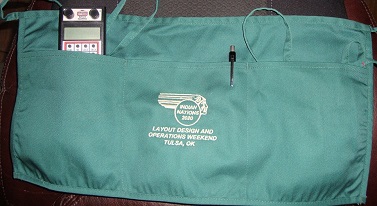 Waist Apron
Waist Apron
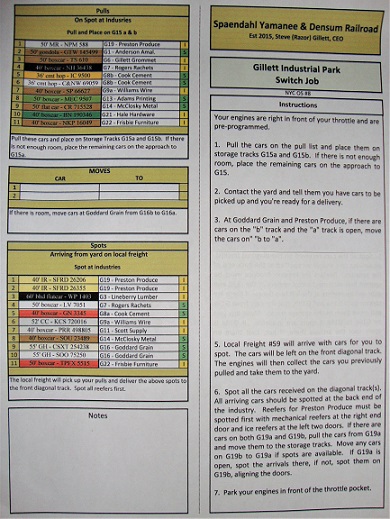 Switch List
Switch List
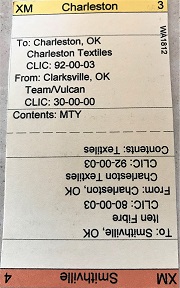 Waybill
Waybill
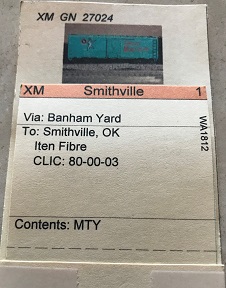 Waybill in Car Card
Waybill in Car Card
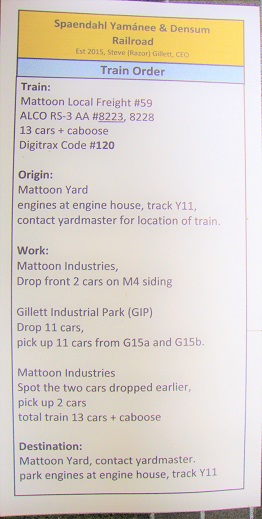 Train Order
Train Order
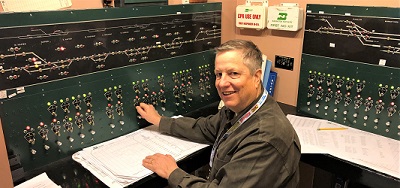 Dispatch Station
Dispatch Station
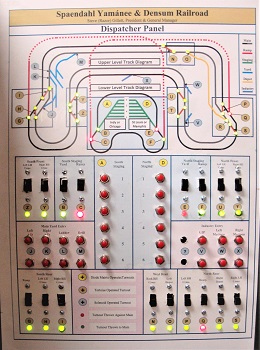 Dispatch Panel
Dispatch Panel
 CLIC Chart
CLIC Chart
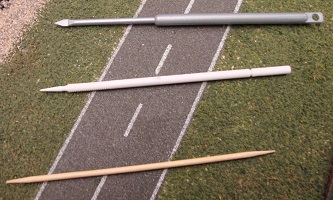 Uncoupling Picks
Uncoupling Picks